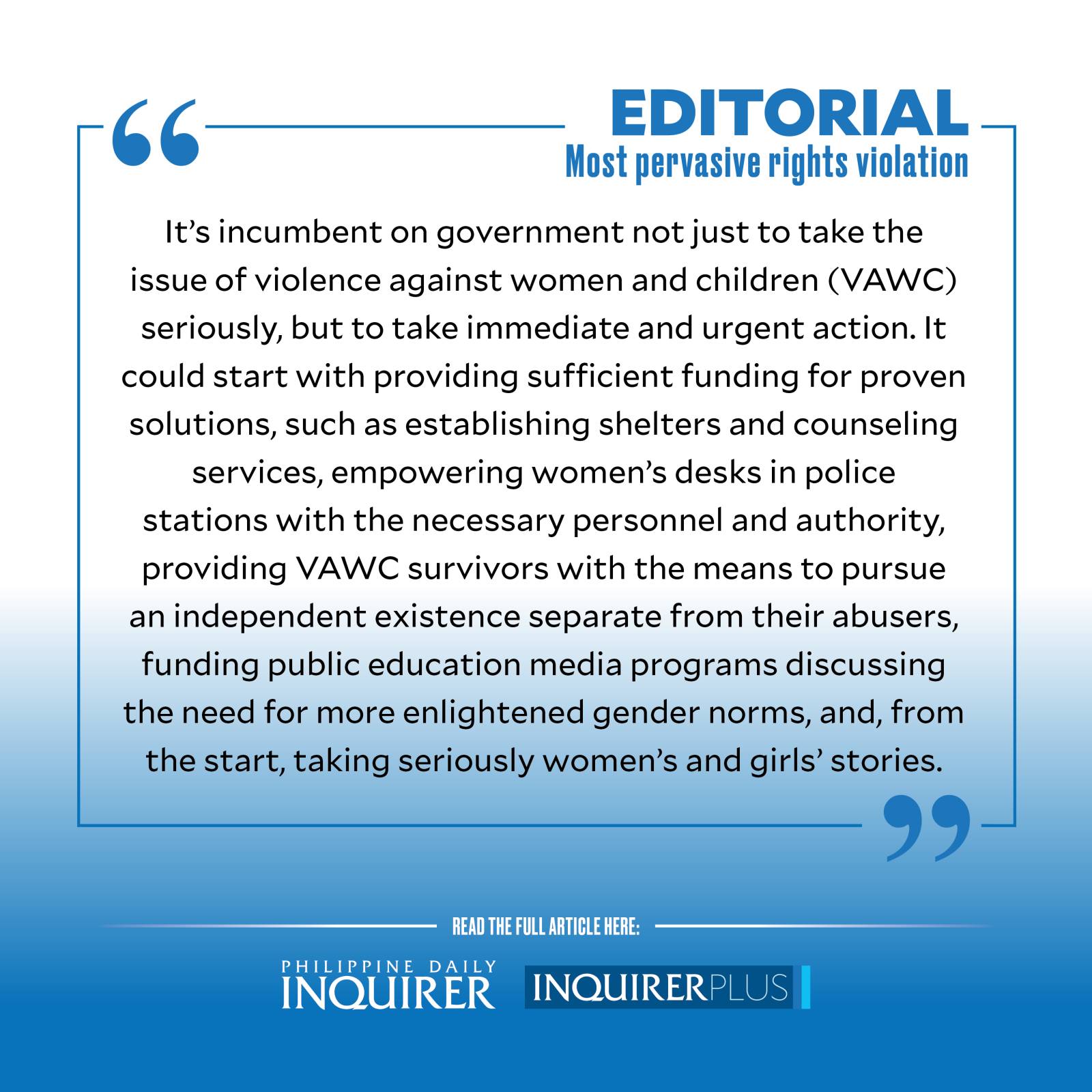Most pervasive rights violation
It is much more than an irony that the home, where presumably one feels safest and most protected, is for many women and children, a place they fear and dread.
Neither do they feel safe out in the world: on the streets, in schools, in workplaces, in public spaces like markets, malls, movie houses, and even in cyberspace.
Article continues after this advertisementThis is because violence against women and girls, as 11 United Nations entities asserted in a recent statement, “is not only one of the worst forms of discrimination but also remains the most widespread and pervasive human rights violation in the world.”
True, it is difficult to wrap one’s mind around the concept of violence against women as a human rights violation. This is because, until recently, human rights were often thought of and spoken about in connection with political and civic rights. Violence against women and their children (VAWC), on the other hand, was often considered a “private” violation, one that occurred and should be addressed within the confines of the home and the family.
And yet as millions of women (and some men) and children can attest, violence against them is very much present in public spaces, with implications on public policy and welfare and, indeed, with impact felt well beyond the present, and down through the generations.
Article continues after this advertisementToday is the final day marking the commemoration of the “16 Days of Activism against Gender-Based Violence,” which began last Nov. 25, the International Day for the Elimination of Violence against Women, and ends today, Human Rights Day.
In an interview with this paper, British Ambassador to the Philippines Laure Beaufils called for a “zero tolerance” approach to all forms of gender-based violence. She bemoaned that while there has been some improvement on several fronts, the world “hasn’t made any progress as the numbers (of VAWC cases) are pretty much still the same over the past 10 years.”
In this country, despite laws protecting women and children, one in four women still experience gender-based violence, with 41 percent of victims opting not to seek help. The situation was exacerbated all the more during the COVID lockdowns, with, in the opinion of experts, “the lockdowns (providing) cover for abuse of women and children with cases remaining invisible and access to help for victims shrinking.”
While the problem of VAWC is pervasive and stubborn, eliminating it is not impossible. The UN agencies believe that “large-scale reductions … can be achieved through intensive feminist activism and advocacy coupled with evidence and practice-informed multisectoral action and investment.”
Beaufils, however, believes that there is still “a need for a contextualized approach as the response would be different in different countries.” All the approaches that have worked in different countries, the ambassador adds, “have at their core gender transformative elements where you transform understanding of gender and norms.”
This involves, she said, ensuring that there is no gender stereotyping in school books and in the curriculum, as well as involving men in discussions and having them speak out against violence against women.
Beaufils, the first woman British ambassador to the Philippines, also lamented how the burden of challenging gender-based violence has fallen on women, when “every single man can play a role just by not laughing at sexist jokes, (and start) saying no to anything that is discriminatory to women.”
Governments must also empower women politically, economically, and socially, and maintain victim support so they could challenge their abusers before the courts, Beaufils added. “There’s still this pernicious sense that it’s still women’s fault and women’s guilt,” referring to how women often don’t report abuse for fear they would not be taken seriously.
It’s incumbent on government, then, especially on officials, not just to take the issue of VAWC seriously, but to take immediate and urgent action. It could start with providing sufficient funding for proven solutions, such as establishing shelters and counseling services, empowering women’s desks in police stations with the necessary personnel and authority, providing VAWC survivors with the means to pursue an independent existence separate from their abusers, funding public education media programs discussing the need for more enlightened gender norms, and, from the start, taking women’s and girls’ stories seriously.
It should also culminate in serious pursuit of the identification and arrest of perpetrators, and dogged follow-up through the criminal justice system for proper judgment and punishment.
In other words, the fight against violence against women must involve not just women but men, too, as well as all of society.

















